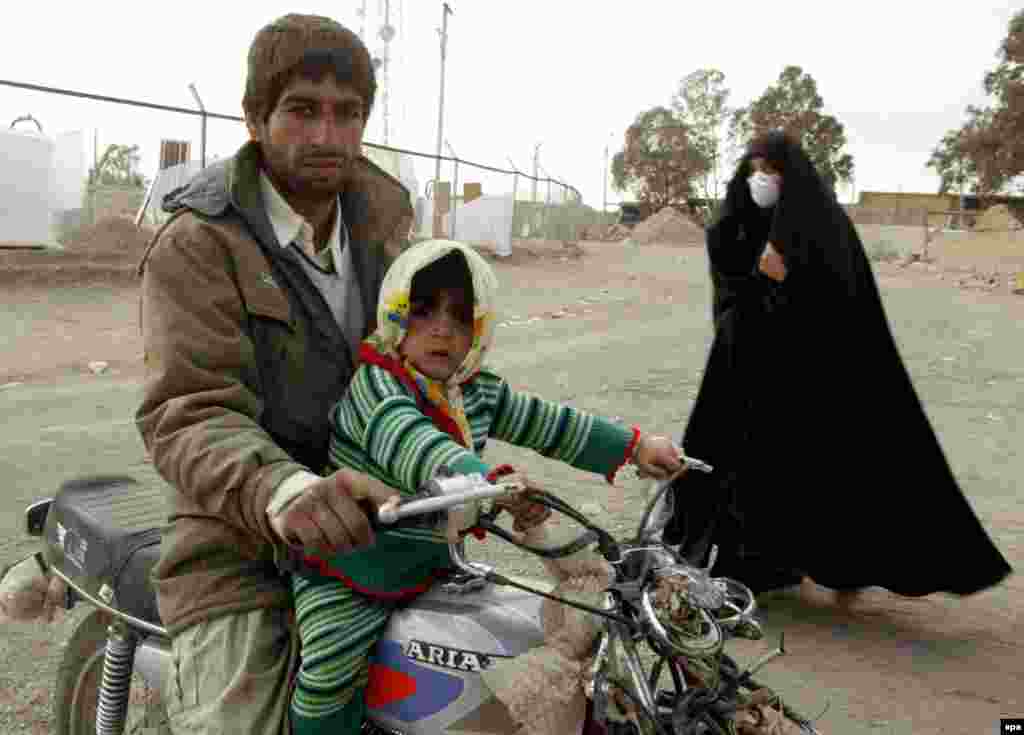MORE: Coverage in Farsi from Radio Farda.
Bam Earthquake: Three Years On

1
Residents of Bam visiting the graves of victims of the December 26, 2003, earthquake (Fars) - The southern Iranian city of Bam is marking the third anniversary of a devastating earthquake that left more than 26,000 people dead and destroyed one of the country's great historical sites.

2
Mourning banners being prepared in Bam in advance of the third anniversary of the earthqake (Fars) - Before the earthquake, Bam -- which is located about 200 kilometers south of Kerman -- had a population of just over 78,000. The jewel of the city was a well-preserved 2,500-year-old mud-brick citadel.

3
Residents of Bam grieving for victims on the day after the earthquake (epa) - Initially, Iranian authorities put the Bam death toll at more than 40,000. That figure has since been reduced to some 26,000. The earthquake was of magnitude 6.6.

4
A Bam resident and his daughter on January 2, 2004 (epa) - The earthquake struck at 5:27 a.m. local time on Saturday, December 26, 2004. Experts believe the epicenter was very close to the city of Bam and that the earthquake occurred close to the surface, intensifying the damage.

5
A Polish rescue worker takes a break during the search for victims (epa) - An estimated 30,000 people were injured in the earthquake and many thousands were left homeless. The BBC reported that about "70 percent of the modern city of Bam" was destroyed.

6
A woman in Tehran on January 2, 2004, mourns for victims of the Bam earthquake (epa) - "The historic quarter of Bam has been completely destroyed and many of our countrymen are underneath the ruins," said Mohammad Ali Karimi, the governor of Kerman Province, at the time. The disaster sparked a massive domestic and international humanitarian-relief effort.

7
An undated photograph of the historical center of Bam before the earthquake (Creative Commons) - The ancient citadel at Bam is about 2,500 years old. Most of its buildings date from the Safavid dynasty. The fortress and city were largely abandoned after an Afghan invasion in 1722. Afterward, it was gradually resettled.

8
A view of the Bam citadel shortly after the earthquake (Fars) - At its historical peak, some 11,000 people lived within the mud-brick walls of the citadel. Its walls enclosed an area of 6 square kilometers and it boasted 38 towers.

9
Tourists visting the Bam complex after the 2003 earthquake (Fars) - After the turn of the 20th century, the Bam citadel was used as a military barracks. However, the government abandoned it in 1932.

10
The ruins of the Bam complex today (Fars) - In 1953, the Iranian authorities undertook major excavation and restoration works at Bam. The project led to a brief flowering of tourism to the city.

11
People left homeless by the earthquake living in tents in early 2004 (Fars) - In January 2004, the United Nations estimated it would take some $1 billion to rebuild Bam and provide assistance to earthquake victims. The UN sought some $73 million for immediate, short-term aid to the injured and homeless.

12
Three years after the earthquake, many in Bam continue to live in Red Crescent tents (Fars) - After the earthquake, the UN estimated that it would take at least two years to rebuild Bam, if the Iranian government took the lead and the international community provided needed aid. Today the reconstruction effort continues.

13
Reconstruction work in Bam on the third anniversary of the earthquake (Fars) - Recovery work is still going on in Bam, both in the city and at the citadel. In the run-up to the anniversary, the city was decked out in mourning banners and people from around the country flocked to the graves of relatives who died in the disaster.

14
A view of the Bam citadel shortly after the 2003 earthquake (Fars) - Earlier this month, archaeolgists working at the Bam citadel reported that Bronze Age potshards had been found under the debris. "Once the debris was removed and while we were studying the mosque, we realized that its architecture had undergone many alterations through the centuries," archaeologist Leili Sajadi told CHN.





 For weekly news and analysis on Iran by e-mail,
For weekly news and analysis on Iran by e-mail,